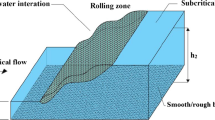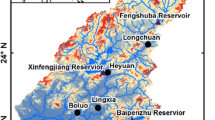Abstract
Flow vegetation interaction is a complex process affected by physical parameters, such as flow depth, vegetation height, stem characteristics, vegetation density, and submergence conditions. Corelation matrix of dependent and independent variables shows a direct corelation of flow velocity with vegetation density, the height of the vegetation, flow depth and the slope of the channel, and an inverse relation with non-dimensional coefficient of drag, the diameter of the cylindrical vegetation. In this study, three soft computing techniques, namely, group method data handling (GMDH), optimizable Gaussian process regression (GPR), and ensemble tree (ET–B) models with Bayesian optimization, are employed to precisely estimate the flow velocity in vegetated channel. These methods have effective data mining capacity, making them suitable for predicting flow velocity considering many independent parameters. Taylor diagram of results shows superior performance of GMDH (R = 0.982, RMSD = 0.054 for testing) over GPR–B (R = 0.969, RMSD = 0.069 for testing) and ET–B (R = 0.927, RMSD = 0.1 for testing). The convergence of ET–B is faster than GMDH and GPR–B, making it a more computationally efficient model.







Similar content being viewed by others
Data availability
Data are available on request from corresponding author.
References
Akçay MT, Akgundogdu A, Tiryaki H (2021) Estimation of the average speed for a railway signaling system by using gaussian process regression methods with Bayesian optimization. Demiryolu Mühendisliği 14:274–286
Baptist MJ, Babovic V, Rodríguez Uthurburu J, Keijzer M, Uittenbogaard RE, Mynett A, Verwey A (2007) On inducing equations for vegetation resistance. J Hydraul Res 45(4):435–450
Baptist, M. J. (2003). A flume experiment on sediment transport with flexible, submerged vegetation. In International workshop on riparian forest vegetated channels: hydraulic, morphological and ecological aspects, RIPFOR, Trento, Italy.
Bijanvand S, Mohammadi M, Parsaie A, Mandala V (2023) Modeling of discharge in compound open channels with convergent and divergent floodplains using soft computing methods. J Hydroinf 25(5):1713–1727
Bui MD, Kaveh K, Penz P, Rutschmann P (2015) Contraction scour estimation using data-driven methods. J Appl Water Eng Res 3(2):143–156
Choi SU, Kang H (2006) Numerical investigations of mean flow and turbulence structures of partly-vegetated open-channel flows using the Reynolds stress model. J Hydraul Res 44(2):203–217
Ebtehaj I, Bonakdari H, Zaji AH, Azimi H, Khoshbin F (2015) GMDH-type neural network approach for modeling the discharge coefficient of rectangular sharp-crested side weirs. Eng Sci Technol Int J 18(4):746–757
Fischer-Antze T, Stoesser T, Bates P, Olsen NRB (2001) 3D numerical modelling of open-channel flow with submerged vegetation. J Hydraul Res 39(3):303–310
Galema, A. (2009). Evaluation of vegetation resistance descriptors for flood management (Doctoral dissertation, Master Thesis. University of Twente, Enschede, Netherlands).
Hamoudi Y, Amimeur H, Aouzellag D, Abdolrasol MG, Ustun TS (2023) Hyperparameter Bayesian optimization of gaussian process regression applied in speed-sensorless predictive torque control of an autonomous wind energy conversion system. Energies 16(12):4738
Huang HQ, Nanson GC (1997) Vegetation and channel variation; a case study of four small streams in southeastern Australia. Geomorphology 18(3–4):237–249
Huthoff, F., Augustijn, D. C., & Hulscher, S. J. (2007). Analytical solution of the depth‐averaged flow velocity in case of submerged rigid cylindrical vegetation. Water resources research, 43(6).
Ivakhnenko AG (1971) Polynomial theory of complex systems. IEEE Trans Syst Man Cybern 4:364–378
Jha A, Kumar B (2013) Particle swarm optimization neural network for flow prediction in vegetative channel. J Intell Syst 22(4):487–501
Ji C (2021) Predicting fuel consumptions and exhaust gas emissions for LNG carriers via machine learning with hyperparameter optimization. In: SNAME 26th Offshore Symposium. OnePetro.
Kalogirou SA (2002) Artificial intelligence in renewable energy systems modelling and prediction.
Khosravi K, Cooper JR, Daggupati P, Pham BT, Bui DT (2020) Bedload transport rate prediction: application of novel hybrid data mining techniques. J Hydrol 585:124774
Kopsiaftis G, Protopapadakis E, Voulodimos A, Doulamis N, Mantoglou A (2019) Gaussian process regression tuned by bayesian optimization for seawater intrusion prediction. Comput Intell Neurosci.
Kumar B (2014) Flow prediction in vegetative channel using hybrid artificial neural network approach. J Hydroinf 16(4):839–849
Malkinson D, Wittenberg L (2007) Scaling the effects of riparian vegetation on cross-sectional characteristics of ephemeral mountain streams—a case study of Nahal Oren, Mt. Carmel, Israel. Catena 69(2): 103–110.
Malkinson D, Kadmon R (2006) The effects of inter-plant interactions and density-dependent disturbances on vegetation pattern formation. Landscape Ecol 21(2):259–270
McKenney R, Jacobson RB, Wertheimer RC (1995) Woody vegetation and channel morphogenesis in low-gradient, gravel-bed streams in the Ozark Plateaus, Missouri, and Arkansas. Geomorphology 13(1–4):175–198
Mohammed Saleh LA, Majeed SAAD, Alnasrawi FAEKM (2019) Numerical study of the bridge pier scour using gene expression programming. J Appl Water Eng Res 7(4):287–294
Mohammed AY, Sharifi A (2023) Estimating discharge coefficient of triangular free overfall using the GMDH technique. Water Supply 23(9):3775–3788
Morita Y, Rezaeiravesh S, Tabatabaei N, Vinuesa R, Fukagata K, Schlatter P (2022) Applying Bayesian optimization with Gaussian process regression to computational fluid dynamics problems. J Comput Phys 449:110788
Najafzadeh M, Azamathulla HM (2013) Group method of data handling to predict scour depth around bridge piers. Neural Comput Appl 23(7):2107–2112
Nash JE, Sutcliffe JV (1970) River flow forecasting through conceptual models part I—A discussion of principles. J Hydrol 10(3):282–290
Neary VS (2003) Numerical solution of fully developed flow with vegetative resistance. J Eng Mech 129(5):558–563
Niu WJ, Feng ZK (2021) Evaluating the performances of several artificial intelligence methods in forecasting daily streamflow time series for sustainable water resources management. Sustain Cities Soc 64:102562
Parsaie A, Haghiabi AH (2021) Mathematical expression for discharge coefficient of Weir-Gate using soft computing techniques. J Appl Water Eng Res 9(3):175–183
Parsaie A, Azamathulla HM, Haghiabi AH (2020) Physical and numerical modeling of performance of detention dams. J Hydrol 581:121757
Parsaie A, Dehdar-Behbahani S, Chadee AA, Haghiabi AH (2023) Estimating the energy dissipation of flow passing over triangular and trapezoidal plan weirs using the GMDH model. Water Practice Technol 18(5):1115–1124
Pattanaik ML, Choudhary R, Kumar B (2020) Prediction of frictional characteristics of bituminous mixes using group method of data handling and multigene symbolic genetic programming. Eng Comput 36(4):1875–1888
Puri, D., Sihag, P., Sadeghifar, T., Dursun, O. F., & Thakur, M. S. (2023). Soft computing-based model development for estimating the aeration efficiency through Parshall flume and Venturi flumes. Multiscale and Multidisciplinary Modeling, Experiments and Design, 1–13.
Rahman SA, Chakrabarty D (2020) Sediment transport modelling in an alluvial river with artificial neural network. J Hydrol 588:125056
Rasmussen CE, Williams CKI (2006) Gaussian processes for machine learning; Cambridge, MA.
Rocca J (2019) Ensemble methods: bagging, boosting and stacking. Medium towards data science.
Roy SM, Pareek CM, Kim T, Mal BC (2023) Artificial intelligence-based approach for improving the aeration efficiency of a perforated plate aeration system. Multiscale and Multidiscip. Model. Exp. and Des.
Safari MJS, Ebtehaj I, Bonakdari H, Es-haghi MS (2019) Sediment transport modeling in rigid boundary open channels using generalize structure of group method of data handling. J Hydrol 577:123951
Sakaa B, Chaffai H, Hani A (2020) ANNs approach to identify water demand drivers for Saf-Saf river basin. J Appl Water Eng Res 8(1):44–54
Schmidhuber J (2015) Deep learning in neural networks: an overview. Neural Netw 61:85–117
Stone BM, Shen HT (2002) Hydraulic resistance of flow in channels with cylindrical roughness. J Hydraul Eng 128:500–506
Tamiru H, Dinka MO (2021) Application of ANN and HEC-RAS model for flood inundation mapping in lower Baro Akobo River Basin. Ethiopia J Hydrol 36:100855
Taylor KE (2001) Summarizing multiple aspects of model performance in a single diagram. J Geophys Res 106(D7):7183–7192
Wu CL, Chau KW (2013) Prediction of rainfall time series using modular soft computing methods. Eng Appl Artif Intell 26(3):997–1007
Yang CT, Marsooli R, Aalami MT (2009) Evaluation of total load sediment transport formulas using ANN. Int J Sedim Res 24(3):274–286
Yarahmadi MB, Parsaie A, Shafai-Bejestan M, Heydari M, Badzanchin M (2023) Estimation of Manning roughness coefficient in alluvial rivers with bed forms using soft computing models. Water Resources Management, 1–22.
Yin L, Tao F, Chen Y, Liu F, Hu J (2021) Improving terrestrial evapotranspiration estimation across China during 2000–2018 with machine learning methods. J Hydrol 600:126538
Author information
Authors and Affiliations
Contributions
BB and SNK analyzed the data and modeling the techniques. BK, BB and SNK conceptualized the work. All authors reviewed the manuscript.
Corresponding author
Ethics declarations
Conflict of interest
The authors declare no competing interests.
Additional information
Publisher's Note
Springer Nature remains neutral with regard to jurisdictional claims in published maps and institutional affiliations.
Rights and permissions
Springer Nature or its licensor (e.g. a society or other partner) holds exclusive rights to this article under a publishing agreement with the author(s) or other rightsholder(s); author self-archiving of the accepted manuscript version of this article is solely governed by the terms of such publishing agreement and applicable law.
About this article
Cite this article
Barman, B., Kashyap, S.N. & Kumar, B. Flow velocity prediction in a vegetated channel using soft computing techniques. Multiscale and Multidiscip. Model. Exp. and Des. (2024). https://doi.org/10.1007/s41939-023-00335-w
Received:
Accepted:
Published:
DOI: https://doi.org/10.1007/s41939-023-00335-w




